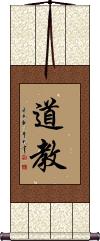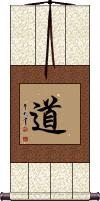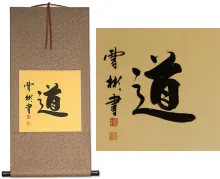Many custom options...
And formats...

Taoism in Chinese / Japanese...
Buy a Taoism calligraphy wall scroll here!
Personalize your custom “Taoism” project by clicking the button next to your favorite “Taoism” title below...
Daoism / Taoism
道教 is the title often used in both Chinese and Japanese to describe the beliefs or religion of Taoism / Daoism.
The first character is simply “dao” and the second character can be translated as “teachings,” “faith” or “doctrine.”
Daoism / Taoism
Literally: The Way or Road
道 is the character “dao” which is sometimes written as “tao” but pronounced like “dow” in Mandarin.
道 is the base of what is known as “Taoism.” If you translate this literally, it can mean “the way” or “the path.”
Dao is believed to be that which flows through all things and keeps them in balance. It incorporates the ideas of yin and yang (e.g. there would be no love without hate, no light without dark, no male without female.)
The beginning of Taoism can be traced to a mystical man named
Lao Zi (604-531 BC), who followed, and added to the teachings of Confucius.
More about Taoism / Daoism here.
Note that this is pronounced “dou” and sometimes “michi” when written alone in Japanese but pronounced “do” in word compounds such as Karate-do and Bushido. It's also “do” in Korean.
Alternate translations and meanings: road, way, path; truth, principle province.
Important Japanese note: In Japanese, this will generally be read with the road, way, or path meaning. Taoism is not as popular or well-known in Japan so Daoist/Taoist philosophy is not the first thing a Japanese person will think of when they read this character.
See our Taoism Page
This in-stock artwork might be what you are looking for, and ships right away...
Not the results for taoism that you were looking for?
Below are some entries from our dictionary that may match your taoism search...
| Characters If shown, 2nd row is Simp. Chinese |
Pronunciation Romanization |
Simple Dictionary Definition |
道 see styles |
dào dao4 tao wataru わたる |
More info & calligraphy: Daoism / Taoism(1) (abbreviation) (See 道・みち・1) road; path; street; route; (2) (See 道・みち・5) way; set of practices; rules for conducting oneself; (3) (abbreviation) (in Japanese schools) (See 道徳教育) moral education; (4) Buddhist teachings; (5) Taoism; (6) administrative region of Japan (Hokkaido); (7) (hist) administrative region of Japan (Tokaido, Tosando, etc.); (8) province (administrative region of Korea); (9) circuit (administrative region of China); (10) (hist) province (Tang-era administrative region of China); (personal name) Wataru mārga. A way, road; the right path; principle, Truth, Reason, Logos, Cosmic energy; to lead; to say. The way of transmigration by which one arrives at a good or bad existence; any of the six gati, or paths of destiny. The way of bodhi, or enlightenment leading to nirvāṇa through spiritual stages. Essential nirvāṇa, in which absolute freedom reigns. For the eightfold noble path v. 八聖道.; The two Ways: (1) (a) 無礙道 or 無間道 The open or unhindered way, or the way of removing all obstacles or intervention, i. e. all delusion; (b) 解脫道 the way of release, by realization of truth. (2) (a) 難行道 The hard way of "works", i. e. by the six pāramitā and the disciplines. (b) 易行道 the easy way salvation, by the invocation of Amitābha. (3) (a) 有漏道 The way of reincarnation or mortality; (b) 無漏 the enlightened way of escape from the miseries of transmigration. (4) (a) 教道 The way of instruction; (b) 證道 the way of realization. (5) The two lower excretory organs. |
陽 阳 see styles |
yáng yang2 yang youji / yoji ようじ |
More info & calligraphy: Yako / Minami(noun - becomes adjective with の) (1) (the) positive; (2) (ant: 陰・2) yang (in Chinese divination); (3) (See 陰に陽に) the open; visible place; public place; (personal name) Yōji The side on which the sun shines, the sun, heat, this life, positive, masculine, dynamic, etc. |
仙人 see styles |
xiān rén xian1 ren2 hsien jen sennin せんにん |
More info & calligraphy: Sennin(1) immortal mountain wizard (in Taoism); mountain man (esp. a hermit); (2) one not bound by earthly desires or the thoughts of normal men; (surname, given name) Sennin seer |
道教 see styles |
dào jiào dao4 jiao4 tao chiao michinori みちのり |
More info & calligraphy: Daoism / TaoismTaoism; Daoism; (personal name) Michinori Taoism. The teaching of the right way, i.e. of Buddhism. |
三尸 see styles |
sanshi さんし |
(See 庚申待) the three worms (in Taoism); worms that inhabit the human gut and, on the eve of the 57th day of the sexagenary cycle, ascend to heaven during one's sleep to report on one's wrongdoings |
三教 see styles |
sān jiào san1 jiao4 san chiao mitsunori みつのり |
the Three Doctrines (Daoism, Confucianism, Buddhism) (1) Shinto, Buddhism and Confucianism; the three religions; (2) Confucianism, Buddhism and Taoism; (3) Buddhism, Shinto and Christianity; (given name) Mitsunori The three teachings, i.e. 儒, 佛 (or 釋), and 道Confucianism, Buddhism, and Taoism; or, 孔, 老, 釋 Confucianism, Taoism (aIso known as 神敎), and Buddhism. In Japan they are Shinto, Confucianism, and Buddhism. In Buddhism the term is applied to the three periods of Śākyamuni's own teaching, of which there are several definitions: (1) The Jiangnan 南中 School describe his teaching as (a) 漸progressive or gradual; (b) 頓 immediate, i.e. as one whole, especially in the 華嚴經; and (c) 不定 or indeterminate. (2) 光統 Guangtong, a writer of the Iater Wei dynasty, describes the three as (a) 漸 progressive for beginners, i.e. from impermanence to permanence, from the void to reality, etc.; (b) 頓 immediate for the more advanced; and (c) 圓complete, to the most advanced, i.e. the Huayan as above. (3) The 三時敎q.v. (4) The 南山 Southern school deals with (a) the 性空of Hīnayāna; (b) 相空of Mahāyāna; and (c) 唯識圓 the perfect idealism. v. 行事鈔中 4. Tiantai accepts the division of 漸, 頓, and 不定 for pre-Lotus teaching, but adopts 漸 gradual, 頓 immediate, and 圓 perfect, with the Lotus as the perfect teaching; it also has the division of 三藏敎 , 通敎 , and 別敎 q.v. |
五葷 五荤 see styles |
wǔ hūn wu3 hun1 wu hun gokun ごくん |
(Buddhism etc) the five forbidden pungent vegetables: leek, scallion, garlic, rape and coriander (See 五辛) five pungent roots (in Buddhism or Taoism) idem 五辛. |
五辛 see styles |
wǔ xīn wu3 xin1 wu hsin goshin ごしん |
see 五葷|五荤[wu3 hun1] (See 五葷) five pungent roots (in Buddhism or Taoism) The five forbidden pungent roots, 五葷 garlic, three kinds of onions, and leeks; if eaten raw they are said to cause irritability of temper, and if eaten cooked, to act as an aphrodisiac; moreover, the breath of the eater, if reading the sutras, will drive away the good spirits. |
仙客 see styles |
senkaku せんかく |
(1) (rare) (See 仙人・1) immortal mountain wizard (in Taoism); (2) (rare) (See 鶴) crane (bird) |
修真 see styles |
xiū zhēn xiu1 zhen1 hsiu chen shuuma / shuma しゅうま |
to practice Taoism; to cultivate the true self through spiritual exercises (personal name) Shuuma |
僊人 仙人 see styles |
sennin せんにん |
(1) immortal mountain wizard (in Taoism); mountain man (esp. a hermit); (2) person not bound by earthly desires |
地仙 see styles |
dì xiān di4 xian1 ti hsien chisen ちせん |
(See 仙人・せんにん・1) earthly immortal (in Taoism) (地行仙) Earth-immortals, or genī, one of the classes of ṛṣis; i. e. bhūdeva = Brahman. |
天仙 see styles |
tiān xiān tian1 xian1 t`ien hsien tien hsien tensen てんせん |
immortal (esp. female); deity; fairy; Goddess; fig. beautiful woman (See 仙人・せんにん・1) heavenly immortal (in Taoism); (given name) Tensen deva-ṛṣi, or devas and rsis, or immortals. Nāgārjuna gives ten classes of ṛṣis whose lifetime is 100, 000 years, then they are reincarnated. Another category is fivefold: 天仙 deva-ṛṣis in the mountains round Sumeru: 神仙 spirit-ṛṣis who roam the air: 人仙 humans who have attained the powers of immortals; 地仙 earth ṛṣis, subterranean; 鬼仙 pretas, or malevolent ṛṣis. |
彭祖 see styles |
péng zǔ peng2 zu3 p`eng tsu peng tsu houso / hoso ほうそ |
Peng Zu (legendary figure of Taoism who lived 800 years) (personal name) Houso |
成仙 see styles |
chéng xiān cheng2 xian1 ch`eng hsien cheng hsien |
(Taoism) to become an immortal |
玉皇 see styles |
yù huáng yu4 huang2 yü huang |
Jade Emperor (in Taoism) |
神仙 see styles |
shén xiān shen2 xian1 shen hsien shinsen しんせん |
Daoist immortal; supernatural entity; (in modern fiction) fairy, elf, leprechaun etc; fig. lighthearted person (1) immortal mountain wizard (in Taoism); Taoist immortal; supernatural being; (2) (in Japan) 11th note of the ancient chromatic scale (approx. C) 神僊 The genī, immortals, ṛṣi, of whom the five kinds are 天, 神, 人, 地, and 鬼仙, i.e. deva, spirit, human, earth (or cave), and preta immortals. |
神僊 see styles |
shén xiān shen2 xian1 shen hsien shinsen しんせん |
(1) immortal mountain wizard (in Taoism); Taoist immortal; supernatural being; (2) (in Japan) 11th note of the ancient chromatic scale (approx. C) immortals |
符籙 符箓 see styles |
fú lù fu2 lu4 fu lu furoku ふろく |
(Taoism) talisman in the form of a painting of symbols thought to have magical powers fulu; protective talisman used historically by Taoist pilgrims in China |
老君 see styles |
lǎo jun lao3 jun1 lao chün |
Laozi or Lao-tze (c. 500 BC), Chinese philosopher, founder of Taoism |
辟穀 辟谷 see styles |
bì gǔ bi4 gu3 pi ku |
(Taoism) to abstain from eating cereals; to fast; also pr. [pi4gu3] |
道仏 see styles |
doubutsu / dobutsu どうぶつ |
(rare) Taoism and Buddhism; (place-name, surname) Dōbutsu |
道学 see styles |
dougaku / dogaku どうがく |
(1) ethics; moral philosophy; (2) (study of) Confucianism (esp. the Cheng-Zhu school of neo-Confucianism); (3) (study of) Taoism; (4) (hist) (See 石門心学) Shingaku (Edo-period moral philosophy); (given name) Dōgaku |
道理 see styles |
dào li dao4 li5 tao li michitada みちただ |
reason; argument; sense; principle; basis; justification; CL:個|个[ge4] reason; logic; sense; truth; right; (given name) Michitada Truth, doctrine, principle; the principles of Buddhism, Taoism, etc. |
全真教 see styles |
zenshinkyou / zenshinkyo ぜんしんきょう |
Quanzhen (school of Taoism); (o) Quanzhen school (Jin dynasty branch of Taoism) |
在理教 see styles |
zài lǐ jiào zai4 li3 jiao4 tsai li chiao Zairi kyō |
The Tsai-li secret society, an offshoot of the White Lily Society, was founded in Shantung at the beginning of the Ch'ing dynasty; the title 'in the li, ' indicating that the society associated itself with all three religions, Confucianism, Taoism, and Buddhism; its followers set up no images, burnt no incense, neither smoked nor drank, and were vegetarian. |
東王公 东王公 see styles |
dōng wáng gōng dong1 wang2 gong1 tung wang kung |
Mu Kung or Tung Wang Kung, God of the Immortals (Taoism) |
紫微宮 紫微宫 see styles |
zǐ wēi gōng zi3 wei1 gong1 tzu wei kung |
palace of Jade emperor (in Taoism) |
趙公明 赵公明 see styles |
zhào gōng míng zhao4 gong1 ming2 chao kung ming |
Zhao Gongming, God of Wealth in the Chinese folk tradition and Taoism |
趙玄壇 赵玄坛 see styles |
zhào xuán tán zhao4 xuan2 tan2 chao hsüan t`an chao hsüan tan |
Zhao Xuantan, God of Wealth in the Chinese folk tradition and Taoism |
Click here for more taoism results from our dictionary
The following table may be helpful for those studying Chinese or Japanese...
| Title | Characters | Romaji (Romanized Japanese) | Various forms of Romanized Chinese | |
| Daoism Taoism | 道教 | doukyou / dokyo | dào jiào / dao4 jiao4 / dao jiao / daojiao | tao chiao / taochiao |
| Daoism Taoism | 道 | michi / -do | dào / dao4 / dao | tao |
Successful Chinese Character and Japanese Kanji calligraphy searches within the last few hours...






